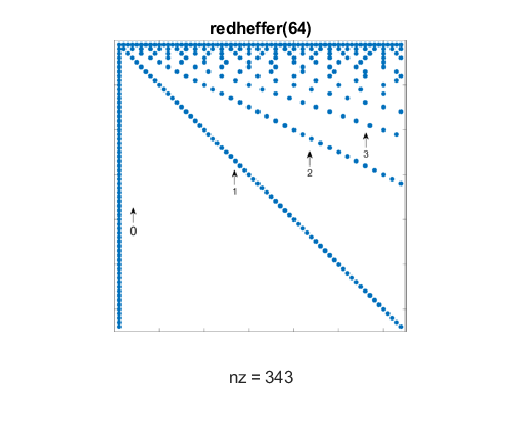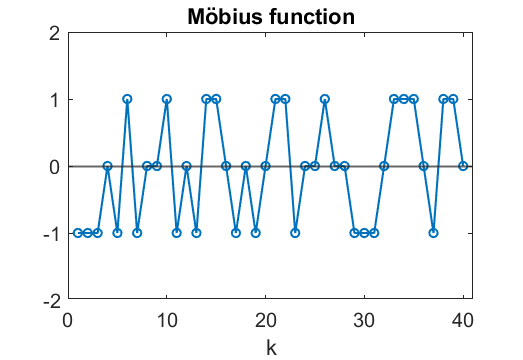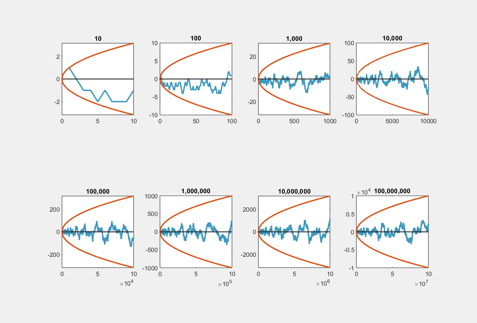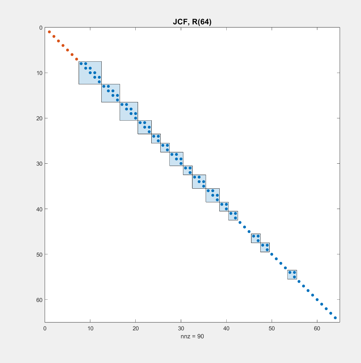| Labfans是一个针对大学生、工程师和科研工作者的技术社区。 | 论坛首页 | 联系我们(Contact Us) |
 |
| Labfans是一个针对大学生、工程师和科研工作者的技术社区。 | 论坛首页 | 联系我们(Contact Us) |
 |
|
|
#1 |
|
高级会员
注册日期: 2019-11-21
帖子: 3,017
声望力: 67  |
The twenty-second Householder Symposium on Numerical Linear Algebra is this week, June 8 - June 13, 2025 at Cornell. My talk on Wednesday had the provocative title "A Million-Dollar Matrix". A PDF of the slides available at link_1. The talk covers posts in the Cleve's Corner blog last fall. link_2, link_3, link_4.
Contents
Ray Redheffer (1921-2005) was a professor of mathematics at UCLA from 1950 until 2000. The Redheffer matrix, which he introduced in 1977, is n-by-n, with elements R(k,j) = 1, if j = 1 or k divides j, = 0, otherwiseHere is a spy plot for n = 64. The nonzero elements lie in the first column and on diagonals with integer-valued slopes.  Möbius Function August Möbius (1790-1868) was an eminent 19th-century German mathematician. His Möbius function is a fundamental tool in the study of prime numbers. mu(k) = 1 if k has an even number of distinct prime factors, = 0 if k has a repeated prime factor, = -1 if k has an odd number of distinct prime factors  Mertens Function Franz Mertens (1840-1927) was born in the Grand Duchy of Posen in the Kingdom of Prussia, which is now Poland. He lived much his life in Vienna, Austria. The Mertens function is the cumulative sum of the Möbius function. $$ M(n) = \sum_{k = 1}^{n} \mu(k) $$ M(n) is a running count of the integers that have an even number of prime factors, minus those with an odd number of prime factors.  Redheffer = Mertens The determinant of the Redheffer matrix is equal to the Mertens function. det(R(n)) = M(n) Plots of M(n) are also plots of det(R(n)). Mertens Conjecture How fast does M(n) grow as n increases? Here are plots of M(n) for n in powers of 10 from n = 10 to n = 10^8, together with plots of sqrt(n) and -sqrt(n).  We see that, at least for n < 10^8, |M(n)| < √nThe Mertens conjecture is that this inequality holds for all n as n → ∞. This conjecture is of interest because it implies the Riemann hypothesis. Riemann Hypothesis The Riemann hypothesis has been called the “Most important unsolved problem in mathematics". Its resolution is the objective of a Clay Millenium Prize valued at one-million dollars. The hypothesis, proposed by G. F. Bernard Riemann in 1859, concerns the zeta function ζ(z) and the location of its zeros. Riemann Computations Computation of the first N non-trivial zeros of ζ(s). authors year N ____________________________________ ____ __________________ Riemann 1854 ? Gram 1903 10 Backlund 1914 79 Hutchinson 1925 138 Titchmarsh 1936 1,041 Turing 1953 1,104 Lehmer 1956 25,000 Meller 1958 35,337 Lehman 1966 250,000 Rosser, Yohe, Schoenfield 1969 3,502,500 Brent 1977 40,000,000 Brent 1979 81,000,001 Brent, Van_de_Lune, Te_Riele, Winter 1982 200,000,001 Van_de_Lune, Te_Riele, Winter 1986 1,500,000,001 Van_de_Lune 2001 100,000,000,000 Wedeniwski 2003 250,000,000,000 Gourdon 2004 10,000,000,000,000$1M The Mertens conjecture |M(n)| < √nimplies the Riemann hypothesis and is worth $1M. So, a proof that |det(R(n)| < √nwould earn R the title "Million-Dollar Matrix". Spoiler The Mertens conjecture is false. Andrew Odlyzko and Herman te Riele (1985) prove limsup n→∞ M(n)/√n > 1.06This proves the existence of infinitely many values of n for which |det(R(n))| > 1.06 √nThe proof is indirect. Nobody knows an actual value of n. Estimates are n >> 10^30Redheffer Matrix Even though it is not worth a million dollars, Nick Higham included the Redheffer matrix in the original MATLAB gallery. The command help private/redheffsays A has N-FLOOR(LOG2(N))-1 eigenvalues equal to 1, a real eigenvalue approximately SQRT(N), a negative eigenvalue approximately -SQRT(N), and the remaining eigenvalues are provably "small".For n = 64, this becomes R(64) has 57 eigenvalues equal to 1, a real eigenvalue approximately 8.0, a negative eigenvalue approximately -8.0, and the remaining eigenvalues are provably "small".Eigenvalues The eigenvalues of R(64) are eig(redheffer(64)) 10.0445 + 0.0000i -5.5442 + 0.0000i 0.0726 + 0.0000i 0.3213 + 0.4487i 0.3213 - 0.4487i 0.8923 + 0.1262i 0.8923 - 0.1262i followed by 1.0000 + 0.0000i repeated 57 times.Characteristic polynomial The characteristic polynomial of R(64) is p(z) * (z – 1)^57where p(z) = z^7 - 7^z^6 - 42*z^5 + 127*z^4 - 130*z^3 + 67*z^2 - 18*z + 1Jordan Canonical Form  Code typemobius.mfunction mu = mobius(n) % mu = mobius(n) mu = ones(1,n); mu(1) = -1; for p = primes(n) mu(p^2:p^2:n) = 0; mu(p:p:n) = -mu(p:p:n); endendtypemertens.mfunction M = mertens(n) % M = mertens(n) mu = mobius(n); M = cumsum([1 mu(2:n)]);endtyperedheffer.mfunction R = redheffer(n) % R = redheffer(n) k = 1:n; R = mod(k,k') == 0; R(:,1) = 1; R = double(R);endtypesparse_redheffer.mfunction S = sparse_redheffer(n) % S = sparse_redheffer(n) j(1:n) = (1:n)'; k(1:n) = 1; m = n; for i = 2:n t = [1 i:i:n]'; p = length(t); j(m+(1:p)) = t; k(m+(1:p)) = i; m = m+p; end S = sparse(k,j,1,n,n);endSparse Redheffer n tictoc bytes nnz sparsity det |det|/√n 10^1 0.000 664 36 0.3600000 -1 0.316 10^2 0.000 10,104 581 0.0581000 1 0.100 10^3 0.003 137,096 8,068 0.0080680 2 0.063 10^4 0.021 1,738,680 103,667 0.0010367 -23 0.230 10^5 0.216 21,067,992 1,266,749 0.0001267 -48 0.152 10^6 2.515 247,520,536 14,970,033 0.0000150 212 0.212 10^7 32.429 2,843,605,816 172,725,363 0.0000017 1037 0.328Five Ways typefivewaysfunction M = fiveways(n) % Five Ways to Compute the Mertens/Redheffer Function %1 R = redheffer(n); M(1) = det(R); %2 R = sparse_redheffer(n); [L,U,P,Q] = lu(R); M(2) = det(L)*det(U)*det(P)*det(Q); %3 R = sparse_redheffer(n); R(:,[1 n]) = R(:,[n 1]); M(3) = -det(R); %4 R = sparse_redheffer(n); T = R(2:n,2:n); e = ones(1,n-1); M(4) = 1 - e*(T\e'); %5 mu = mobius(n); cmu = cumsum([1 mu(2:end)]); M(5) = cmu(n);end Complexity redheffer function dets complexity M #1 full gallery 1 n^3 1 #2 sparse lu 4 n*log(n)^2 1 #3 sparse swap 1 n*log(n)^2 1 #4 sparse \ 0 n*log(n) 1 #5 none primes 0 n*log(log(n)) manyTiming 2e4 2e5 2e6 2e7 #1 26.33 - - - #2 0.36 21.53 - - #3 0.08 1.29 16.71 - #4 0.05 0.57 6.32 70.85 #5 0.01 0.03 0.27 3.18 Time (seconds)References
|
|
|

|